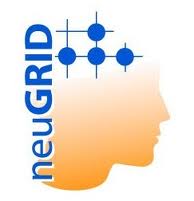Grid computing, the forerunner to today’s more popular cloud-based approach to IT, is being used to create advances in the biomedical field. A pan-European grid computing infrastructure, known as the neuGRID project, was established in 2008 to advance new treatments for neurological diseases such as Alzheimer’s. The goal was to become the “Google for Brain Imaging,” i.e., to provide “a centrally-managed, easy-to-use set of image analysis tools with which scientists can answer complex neuroscientific questions.”
 The project ran from February 1, 2008, to January 31, 2011, and enabled the processing of thousands of brain scans in less than two weeks instead of five years normally required with traditional methods. The condensed discovery process means that researchers can detect early traces of Alzheimer’s, which should lead to better prognoses.
The project ran from February 1, 2008, to January 31, 2011, and enabled the processing of thousands of brain scans in less than two weeks instead of five years normally required with traditional methods. The condensed discovery process means that researchers can detect early traces of Alzheimer’s, which should lead to better prognoses.
According to the project website:
The aim of neuGRID was to build a new, user-friendly Grid-based research e-Infrastructure based on existing e-Infrastructures by developing a set of generalised and reusable medical services in order to enable the European neuroscience community to carry out research required for the study of degenerative brain diseases.
Researchers from seven countries worked for three years to develop the infrastructure using EUR 2.8 million in funding from the European Commission. The initial prototype system was comprised of five distributed nodes of 100 cores (CPUs) each, connected with grid middleware and accessible via the Internet with a user-friendly interface. Workability tests were run using datasets of images from the Alzheimer’s Disease Neuroimaging Initiative (ANDI), the largest public database of MRI brain scans documenting the progression of Alzheimer’s disease and mild cognitive impairment. The role of neuGRID was to connect the imaging data with facilities and services for computationally-intensive data analyses.
Principal Investigator Giovanni Frisoni, a neurologist and the deputy scientific director of IRCCS Fatebenefratelli, the Italian National Centre for Alzheimer’s and Mental Diseases, commented on the impetus for the project:
“neuGRID was launched to address a very real need. Neurology departments in most hospitals do not have quick and easy access to sophisticated MRI analysis resources. They would have to send researchers to other labs every time they needed to process a scan. So we thought, why not bring the resources to the researchers rather than sending the researchers to the resources?”
The results were truly remarkable, as explained by Dr. Frisoni:
“In neuGRID we have been able to complete the largest computational challenge ever attempted in neuroscience: we extracted 6,500 MRI scans of patients with different degrees of cognitive impairment and analysed them in two weeks, on an ordinary computer it would have taken five years!”
Going forward, neuGRID will live on in the form of a spin-off project, called neuGRID for You (N4U), which is adding high performance computing (HPC) and cloud computing resources to the original grid infrastructure. With EUR 3.5 million in European Commission funding, N4U is set to become a virtual laboratory for neuroscientists by expanding the user services, algorithm pipelines and datasets.
“In neuGRID we built the grid infrastructure, addressing technical challenges such as the interoperability of core computing resources and ensuring the scalability of the architecture. In N4U we will focus on the user-facing side of the infrastructure, particularly the services and tools available to researchers,” Dr. Frisoni says. “We want to try to make using the infrastructure for research as simple and easy as possible. The learning curve should not be much more difficult than learning to use an iPhone!”
An excerpt from the final report highlights the “business case” for employing the grid/cloud model in research:
During its implementation, neuGRID has pioneered the use of distributed computing in biomedical research. The successful data challenge and success of the user training sessions have proved the validity of the neuGRID concept, justifying the effort of populating the infrastructure with services that neuroscientists need for their daily research activity. It illustrates that a new way of doing science in computational neuroscience, where data algorithms and CPUs are de-coupled from the physical location of the neuroscience lab and externalised to the grid, is realistic and feasible. While it is quite natural to believe that if cloud computing (i.e. outsourcing data, applications, and computational resources) is working for corporate business, it might also work for research, providing empirical proof that this is the case if of course at the same time mandatory and greatly persuasive.
neuGRID’s original mandate was to enable neuroscientists to quickly and efficiently analyse MRI scans of the brains of patients with Alzheimer’s disease. Not only has the team been successful in that endeavor, but now their work has created a use case for grid computing that can be applied to other neurological disorders and additional areas of medicine. The architecture is “such that generic medical services can be flexibly adapted to be interfaced to others, specific to areas outside Alzheimer’s and the neurosciences,” the website explains.
Neelie Kroes, European Commission Vice-President for the Digital Agenda, said: “Today’s e-infrastructures enable us to tackle an unprecedented amount of available data and an increasing complexity of modern experiments. The neuGRID initiative allows scientists in the smallest laboratories of the most remote areas to access data treasures and help patients suffering from dementia. It is up to the scientific community to make the most of this remarkable instrument, to cooperate and break traditional barriers, thus bringing us one decisive step closer to doing away with Alzheimer’s and other brain degenerative diseases.”



























































